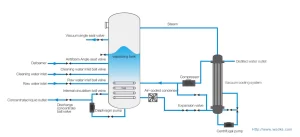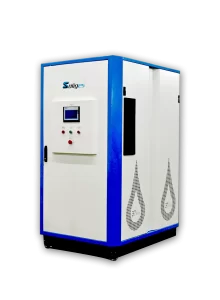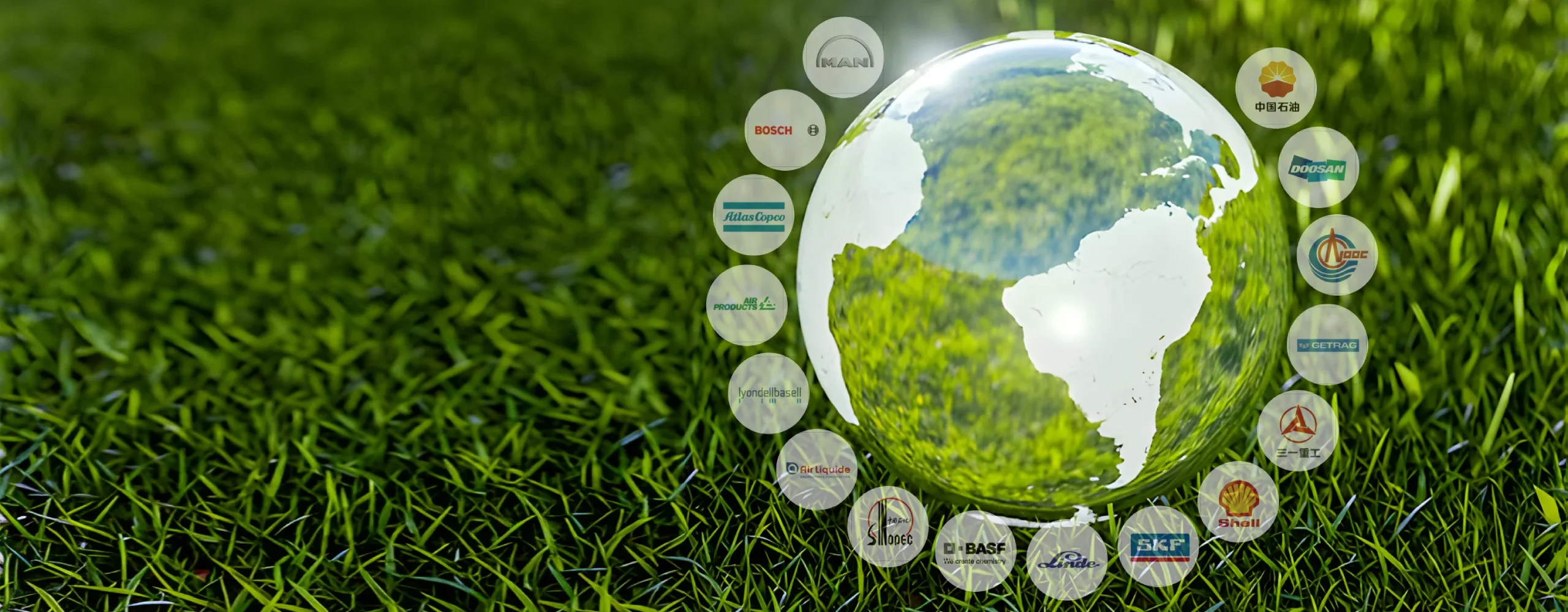Low-temperature evaporation technology is an efficient and energy-saving evaporation method. Low-temperature evaporation refers to an evaporation process with an operating temperature generally between 35 and 50 °C. It is particularly suitable for treating solutions with high concentrations, high salt content or heat-sensitive substances. Its core principle is to use a vacuum pump to reduce the pressure inside the evaporator, thereby reducing the boiling point of the solution, so that evaporation can be performed at a relatively low temperature.
Working principle of low-temperature evaporation technology:
Preheating: This step is fully automatic. After the raw water bucket reaches the middle liquid level, the water pump runs to generate a vacuum, the evaporator automatically fills with water, and the compressor runs to generate heat to heat the wastewater in the evaporation tank. Under vacuum, the wastewater temperature rises to about 30 °C, the wastewater begins to evaporate, and the preheating is completed.
Evaporation and concentration process: The evaporation temperature is set to 35-40 °C, the compressor compresses the refrigerant to generate heat, and while the water evaporates rapidly, the refrigerant absorbs heat after being gasified through the expansion valve to refrigerate, the vapor rises and meets the cold liquid to liquefy and enter the water storage tank, the refrigerant absorbs heat, and is compressed and heated by the compressor to reheat the wastewater. If bubbles rise during the evaporation process, the sensor detects it and the defoamer is automatically added to eliminate the bubbles. After one cycle is completed, the concentrate begins to be discharged (the time of one cycle can be set).
Concentrate discharge: After one evaporation cycle is completed, the compression pump stops working, the pneumatic valve of the concentrate pipeline opens, the evaporation tank is pressurized, and the concentrate is pressed into the concentrate barrel.

Principle and characteristics of low-temperature evaporation technology:
Vacuum decompression: The gas inside the evaporator is extracted through a vacuum pump to form a low-pressure environment. Since the boiling point is proportional to the pressure, reducing the pressure can reduce the boiling point of the solution. For example, under standard atmospheric pressure, the boiling point of water is 100°C, but in a vacuum environment, the boiling point may drop to around 30°C to 40°C.
Evaporation and condensation: In a low-pressure environment, the solution begins to evaporate and produce steam. This part of the steam is then introduced into the condenser, where it is cooled and condensed back into a liquid state, thereby achieving the separation of the solvent and the solute.
Vapor compression and reuse: In some low-temperature evaporation systems, the steam is further compressed by the compressor, which increases the temperature and pressure of the steam, allowing it to be recycled in the system as a heat source for heating other parts of the solution. This vapor recompression technology significantly improves the energy efficiency of the system.
Energy-saving characteristics: The low-temperature evaporator uses the principle of low-temperature heat pumps to reuse the low-temperature steam generated during the evaporation process after raising the temperature through the compressor, which greatly reduces the consumption of additional heat energy. Compared with traditional evaporation technology, it can significantly reduce operating costs.
Heat exchange: A heat exchanger is usually installed in the evaporator to recover some of the heat energy and further improve energy efficiency.

Application Status of Low-temperature Evaporation Technology
At present, physical and chemical methods, membrane treatment, high-temperature distillation, biochemical treatment, low-temperature evaporation and other treatment methods are commonly used in industrial waste liquid treatment. The advantages of low-temperature evaporation system are low-temperature evaporation, not easy to produce scale, very short process chain, simple equipment operation, high degree of automation, higher concentration efficiency, more convenient maintenance, and it has been well applied in industrial waste liquid treatment, waste liquid concentration, waste liquid resource utilization, special waste liquid treatment, etc.
A. Garbage leachate concentration: Garbage leachate is a high-concentration organic waste liquid with the characteristics of high COD concentration, high chroma, strong odor, and difficult treatment. At present, reverse osmosis (RO) technology is used for treatment, which still produces RO concentrate with high salt, high chroma, high COD, and difficult biodegradation, accounting for about 20% to 50% of the waste liquid treatment volume.
The leachate concentrate is further concentrated by vacuum low-temperature evaporation. Inorganic salts and volatile substances enter the steam, and some non-volatile pollutants, heavy metals, solid impurities and other substances remain in the concentrate. The concentrate is further reduced by centrifugal separation, filter pressing and other measures. The liquid is returned to the front end of the low-temperature evaporator for circulating evaporation, and the condensate produced meets the standards for discharge or reuse.
After low-temperature evaporation treatment technology, water is separated from the leachate, volatile organic acids, ammonia and volatile hydrocarbons will enter the condensate with the steam, and inorganic substances, heavy metals and most organic substances will remain in the remaining concentrate. The COD, TDS and NH3-N contents in the condensate are all reduced. The evaporation process can concentrate the leachate to about 2% to 10% of the original volume.
B. Hazardous waste liquid concentration: At present, the hazardous waste liquids generated by industry mainly include mechanical processing waste liquid, electroplating waste liquid, cutting fluid, cleaning waste liquid, fluorescent waste liquid and other waste liquids, and their components often contain components clearly specified in the “National Hazardous Waste List”. At present, the main method is to outsource the disposal to a third-party enterprise with disposal qualifications. If the waste is treated by low-temperature evaporation before being transported out, it can greatly save the cost of hazardous industrial waste liquid disposal and energy consumption.
Low-temperature evaporation technology is used in the concentration and reduction of hazardous waste liquid. The waste liquid concentration rate reaches 75%, the impurity concentration in the concentrated liquid is 80%, and the pollutants in the waste liquid are well removed.
C. High-salt and difficult-to-degrade organic waste liquid in coal chemical industry: Coal chemical waste liquid generally has the characteristics of high COD, high salt content, difficult to degrade and toxic substances. Some surfactants are characterized by strong lipophilicity, strong emulsification and dispersion ability, stable properties and not easy to degrade. The concentrated mother liquor is evaporated and crystallized to produce mixed salt. The low-temperature evaporation system can be introduced at the end to crystallize and dry the mother liquor, which can achieve zero discharge of high-salt wastewater in coal chemical industry.
D. Treatment of oilfield waste liquid: Heavy oil waste liquid has the characteristics of high oil content, high suspended matter, and high mineralization. Generally, oil-water separation is carried out by coil heating. The required heat is generally supplied by the boiler. Boiler combustion requires a large amount of high-quality water supply. Water heated to a certain temperature enters the coil for heat exchange. It is difficult to obtain water on site. Generally, the evaporation process is used to evaporate the oilfield waste liquid into high-quality boiler feed water. This not only realizes the treatment of oilfield water, but also provides high-quality water sources for boilers, forming a good resource recycling and reuse model.
Use low-temperature evaporation to treat oil and gas field sewage stations, high-salt and high-hardness heavy oil wastewater, and high-sulfur gas field waste liquid. The silica concentration of heavy oil waste liquid after treatment is ≤ 50 mg/L, the oil content is ≤ 2.0 mg/L, and the conductivity of the distilled water obtained by evaporation is only 17μS/cm, which meets the requirements for boiler feed water. Sulfur-containing waste liquid is softened by adding composite alkali, coagulant, and flocculant, and deep treatment is reused in thermal recovery boilers. Zero discharge is achieved through reasonable planning and combination with other water treatment processes. In addition, low-temperature evaporation technology is used to treat high-salt waste liquid, waste drilling fluid, fracturing return fluid and other waste liquids generated during the drilling process. The treated water can meet the corresponding standards in the “Comprehensive Wastewater Discharge Standard”.
E. Special waste liquid treatment: Low-temperature evaporation is also used in the treatment of special waste liquids such as paint waste liquid, cutting fluid, waste emulsion, fine chemical waste liquid, and electroplating waste liquid. Due to the characteristics of small production volume, high content of difficult-to-degrade organic pollutants, complex composition, and difficulty in treatment, the use of physical and chemical methods and membrane treatment methods has a long process flow, frequent maintenance and repair, and high treatment costs.
F. Resource utilization of waste liquid: Low-temperature evaporation is mainly used for waste acid purification and heavy metal recovery in waste liquid resource utilization, which reduces environmental pollution and realizes resource recycling to a certain extent, and meets the national requirements for environmental protection treatment.
For copper-containing nitric acid waste acid and titanium-containing nitric acid and hydrofluoric acid waste acid, low-temperature heating is used to volatilize nitric acid or hydrofluoric acid and water in the waste acid into gas, and the evaporated acid gas is cooled and condensed to form nitric acid or hydrofluoric acid regeneration acid.
